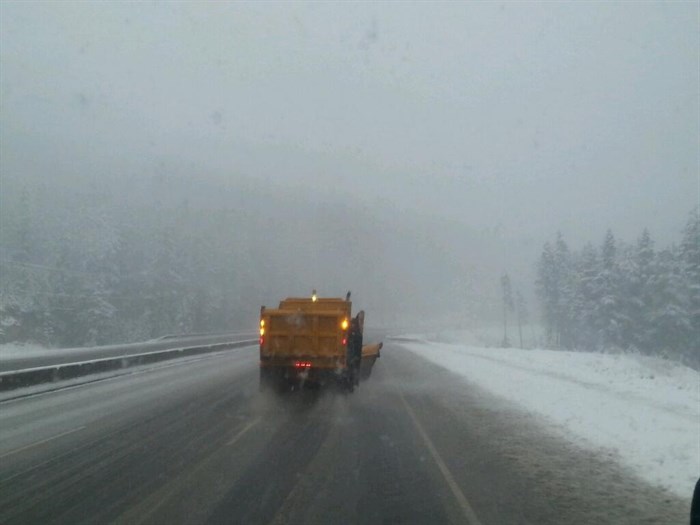
FILE PHOTO - Travelling behind a snow plow on the Coquihalla Highway on Nov 2, 2013.
Image Credit: Contributed/B.C. Ministry of Transportation/Jess M. Cote
November 20, 2018 - 4:30 PM
It’s one of B.C’s busiest mountain highways that connects the Lower Mainland with the Interior, and last week, the provincial government announced commercial trucks are now banned from using the far left lane on Snowshed Hill on the Coquihalla Highway.
It’s an area commonly known for the number of collisions involving commercial vehicles during the winter months.
Last week, the Ministry of Transportation and Infrastructure announced the launch of the No Trucks in the Left Lane pilot program for the three-lane northbound section of the Coquihalla between Box Canyon and Zopkios.
President of the B.C. Trucking Association Dave Earle says they are on board with the province's new measures to increase safety in the selected area, but he says there is more that needs to be done, especially on the education and enforcement side of using winter-driving chains for commercial drivers.
Last winter, 33 out of 35 extended road closures on the Coquihalla Highway involved a commercial vehicle, the ministry says.
“We have to make sure that the people that are cheating, trying to avoid the heavy work and to be fair it’s nasty work putting these (chains) on... but these (drivers) have to get called out because they are causing problems for everybody on the road,” he says.
Earle says this is a problem that can start with erroneous training drivers might receive at the start of their careers.
“In B.C. right now we do not have mandatory entry-level training requirements,” he says.
Earle adds that the B.C. trucking association has been advocating for a mandatory curriculum to show commercial drivers how to chain up their tires properly.
“There are good driving schools that are doing a really good job (at training)… good companies are also doing it, making sure that the drivers have the chains, and they are doing it appropriately and correctly,” he says.
But there are some companies that aren’t.
“Some companies might say ‘forget it, I’ll gamble’ or sometimes the driver might say ‘oh it doesn’t look bad', I’m sure I can make it and then they’ll try it and it’s because they just don’t know,” Earle says.
General manager Sarah VandeGoede with Best Express, a trucking company in Kamloops, says at the beginning of every winter season, drivers are expected to make sure their vehicles are ready for inclement weather conditions when travelling on the highways.
“Pretty well at the beginning of every winter you do the tire changer over Oct. 1,” she says. “At that time I expect the drivers to be checking their chains making sure they are in good working order and the right size for the tire, and that sort of thing… I mean it’s not fun for the driver to be putting the chains on, but they certainly help in the icy times.”
VandeGoede says the specific part of the highway where the ban is currently in effect is known to be problematic for drivers.
“We call it ‘the smasher’ actually, a lot of wrecks happen in that area,” she says. “A lot of the time you’ll see three commercial trucks side-by-side spun out, so I am happy to see one lane dedicated to other traffic.”
Earle says he would like to see more education awareness for winter driving, not only for commercial drivers, but also for drivers of passanger vehicles.
“There doesn’t have to be 15 centimetres of snow an hour to be inclement weather… inclement weather requires different driving equipment,” he says. “There’s this idea that an SUV is fine to do 120 kilometres an hour on the highway with five centimetres of snow… and that’s a problem, we are not doing a good job educating people, in particular on the commercial side.”
Earle says the B.C. Trucking Association has been calling on the provincial government to step up with enforcement of chains by increasing fines and having a heavier presence of Commercial Vehicle Safety Enforcement officers on specific routes.
Currently, the fine for drivers caught without chains or proper winter tires from Oct. 1 to Mar. 31, is $109 fine, and they risk being turned around and sent back they way they came.
To contact a reporter for this story, email Karen Edwards or call (250) 819-3723 or email the editor. You can also submit photos, videos or news tips to the newsroom and be entered to win a monthly prize draw.
We welcome your comments and opinions on our stories but play nice. We won't censor or delete comments unless they contain off-topic statements or links, unnecessary vulgarity, false facts, spam or obviously fake profiles. If you have any concerns about what you see in comments, email the editor in the link above.
News from © iNFOnews, 2018